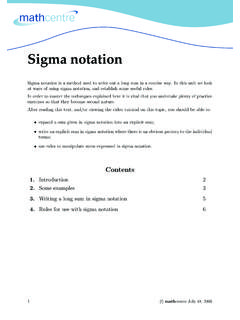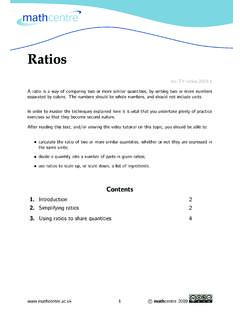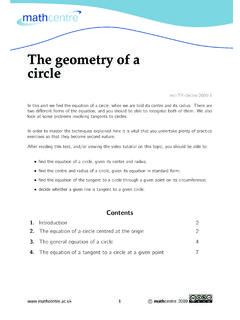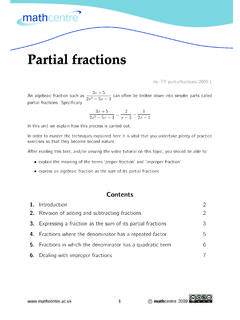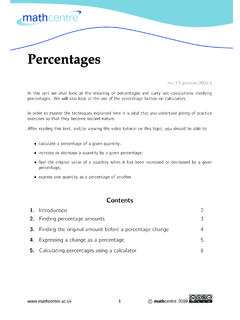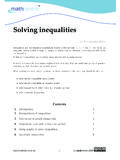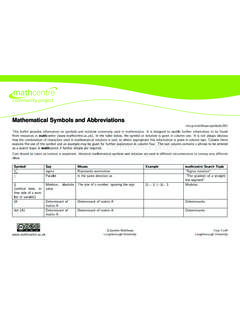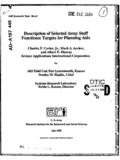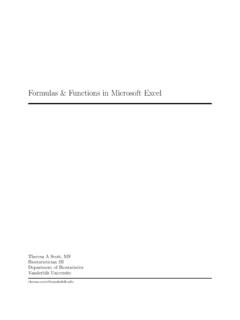Transcription of Polynomial functions - Mathematics resources
1 Polynomial functionsmc-TY- Polynomial -2009-1 Many common functions are Polynomial functions . In this unit we describe Polynomial functionsand look at some of their order to master the techniques explained here it is vital that you undertake plenty of practiceexercises so that they become second reading this text, and/or viewing the video tutorial on this topic, you should be able to: recognise when a rule describes a Polynomial function, and write down the degree of thepolynomial, recognize the typical shapes of the graphs of polynomials , of degree up to 4, understand what is meant by the multiplicity of a root of a Polynomial , sketch the graph of a Polynomial , given its expression as a product of linear is a Polynomial ? of Polynomial points of Polynomial of Polynomial mathcentre 20091.
2 IntroductionA Polynomial function is a function such as a quadratic, a cubic, a quartic, and so on, involvingonly non-negative integer powers ofx. We can give a general defintion of a Polynomial , anddefine its What is a Polynomial ?A Polynomial of degreenis a function of the formf(x) =anxn+an 1xn 1+..+a2x2+a1x+a0where thea s are real numbers (sometimes called thecoefficientsof the Polynomial ). Althoughthis general formula might look quite complicated, particular examples are much simpler. Forexample,f(x) = 4x3 3x2+ 2is a Polynomial of degree 3, as 3 is the highest power ofxin the formula. This is called a cubicpolynomial, or just acubic. Andf(x) =x7 4x5+ 1is a Polynomial of degree 7, as 7 is the highest power ofx. Notice here that we don t need everypower ofxup to 7: we need to know only thehighestpower ofxto find out the degree.
3 Anexample of a kind you may be familiar with isf(x) = 4x2 2x 4which is a Polynomial of degree 2, as 2 is the highest power ofx. This is called containing other operations, such as square roots, are not polynomials . For example,f(x) = 4x3+ x 1is not a Polynomial as it contains a square root. Andf(x) = 5x4 2x2+ 3/xis not a Polynomial as it contains a divide byx .Key PointA Polynomial is a function of the formf(x) =anxn+an 1xn 1+..+a2x2+a1x+ a Polynomial is the highest power ofxin its expression. Constant (non-zero) polynomials , linear polynomials , quadratics, cubics and quartics are polynomials of degree 0, 1,2 , 3 and 4 respectively. The functionf(x) = 0is also a Polynomial , but we say that its degreeis undefined . mathcentre 20093.
4 Graphs of Polynomial functionsWe have met some of the basic polynomials already. For example,f(x) = 2is a constant functionandf(x) = 2x+ 1is a linear (x)x12f(x) = 2f(x) = 2x + 1It is important to notice that the graphs of constant functions and linear functions are alwaysstraight have already said that a quadratic function is a Polynomial of degree 2. Here are someexamples of quadratic functions :f(x) =x2,f(x) = 2x2,f(x) = is the impact of changing the coefficient ofx2as we have done in these examples? Oneway to find out is to sketch the graphs of the (x)xf(x) = x2f(x) = 2x2f(x) = 5x2 You can see from the graph that, as the coefficient ofx2is increased, the graph is stretchedvertically (that is, in theydirection).What will happen if the coefficient is negative?
5 This will meanthat all of the positivef(x)valueswill now become negative. So what will the graphs of the functions look like? The functions arenowf(x) = x2,f(x) = 2x2,f(x) = mathcentre 2009f(x)xf(x) = x2f(x) = 2x2f(x) = 5x2 Notice here that all of these graphs have actually been reflected in thex-axis. This will alwayshappen for functions of any degree if they are multiplied by let us look at some other quadratic functions to see what happens when we vary thecoefficient ofx, rather than the coefficient ofx2. We shall use a table of values in order to plotthe graphs, but we shall fill in only those values near the turning points of the 5 4 3 2 1012x2+x620026x2+ 4x0 3 4 30x2+ 6x 5 8 9 8 5 You can see the symmetry in each row of the table, demonstrating that we have concentratedon the region around the turning point of each function.
6 We can now use these values to plotthe (x)xf(x) = x2 + 4xf(x) = x2 + 6xf(x) = x2 + xAs you can see, increasing the positive coefficient ofxin this Polynomial moves the graph downand to the mathcentre 2009 What happens if the coefficient ofxis negative?x 2 1012345x2 x620026x2 4x0 3 4 30x2 6x 5 8 9 8 5 Again we can use these tables of values to plot the graphs of the (x)xf(x) = x2 4xf(x) = x2 6xf(x) = x2 xAs you can see, increasing the negative coefficient ofx(in absolute terms) moves the graphdown and to the now we know what happens when we vary thex2coefficient, and what happens when wevary thexcoefficient. But what happens when we vary the constant term atthe end of ourpolynomial? We already know what the graph of the functionf(x) =x2+xlooks like, so howdoes this differ from the graph of the functionsf(x) =x2+x+ 1, orf(x) =x2+x+ 5, orf(x) =x2+x 4?
7 As usual, a table of values is a good place to 2 1012x2+x20026x2+x+ 131137x2+x+ 5755711x2+x 4 2 4 4 22 Our table of values is particularly easy to complete since wecan use our answers from thex2+xcolumn to find everything else. We can use these tables of values to plot the graphs of mathcentre 2009f(x)xf(x) = x2 + x + 5f(x) = x2 + x 4f(x) = x2 + x + 1f(x) = x2 + xAs we can see straight away, varying the constant term translates thex2+xcurve , the value of the constant is the point at which the graph crosses thef(x) Turning points of Polynomial functionsA turning point of a function is a point where the graph of the function changes from slopingdownwards to sloping upwards, or vice versa. So the gradientchanges from negative to positive,or from positive to negative.
8 Generally speaking, curves ofdegreencan have up to(n 1)turning instance, a quadratic has only one cubic could have up to two turning points, andso would look something like , some cubics have fewer turning points: forexamplef(x) =x3. But no cubic has more than twoturning mathcentre 2009In the same way, a quartic could have up to threeturning turning points, and so would look some-thing like , some quartics have fewer turning points, but none PointA Polynomial of degreencan have up to(n 1)turning Roots of Polynomial functionsYou may recall that when(x a)(x b) = 0, we know thataandbare roots of the functionf(x) = (x a)(x b). Now we can use the converse of this, and say that ifaandbare roots,then the Polynomial function with these roots must bef(x) = (x a)(x b), or a multiple example, if a quadratic has rootsx= 3andx= 2, then the function must bef(x) =(x 3)(x+2), or a constant multiple of this.
9 This can be extended to polynomials of any example, if the roots of a Polynomial arex= 1,x= 2,x= 3,x= 4, then the function mustbef(x) = (x 1)(x 2)(x 3)(x 4),or a constant multiple of us also think about the functionf(x) = (x 2)2. We can see straight away thatx 2 = 0,so thatx= 2. For this function we have only one root. This is what we call arepeated root,and a root can be repeated any number of times. For example,f(x) = (x 2)3(x+ 4)4hasa repeated rootx= 2, and another repeated rootx= 4. We say that the rootx= 2hasmultiplicity 3, and that the rootx= 4has multiplicity useful thing about knowing the multiplicity of a root is that it helps us with sketching thegraph of the function. If the multiplicity of a root is odd then the graph cuts through thex-axisat the point(x,0).
10 But if the multiplicity is even then the graph just touches thex-axis at thepoint(x,0).For example, take the functionf(x) = (x 3)2(x+ 1)5(x 2)3(x+ 2)4. The rootx= 3has multiplicity 2, so the graph touches thex-axis at(3,0). mathcentre 2009 The rootx= 1has multiplicity 5, so the graph crosses thex-axis at( 1,0). The rootx= 2has multiplicity 3, so the graph crosses thex-axis at(2,0). The rootx= 2has multiplicity 4, so the graph touches thex-axis at( 2,0).To take another example, suppose we have the functionf(x) = (x 2)2(x+ 1). We can seethat the largest power ofxis 3, and so the function is a cubic. We know the possible generalshapes of a cubic, and as the coefficient ofx3is positive the curve must generally increase tothe right and decrease to the left.
